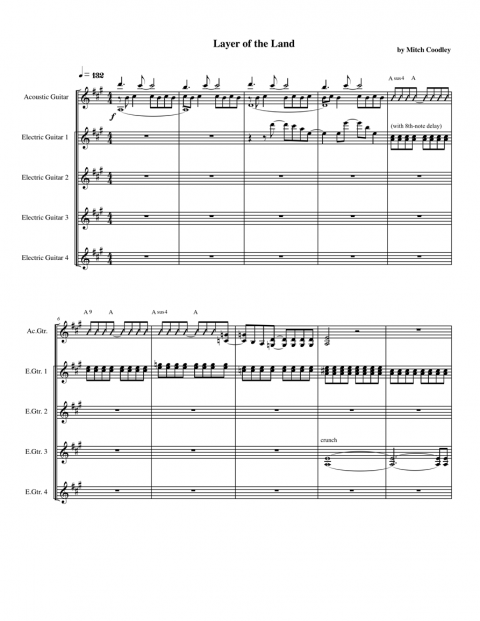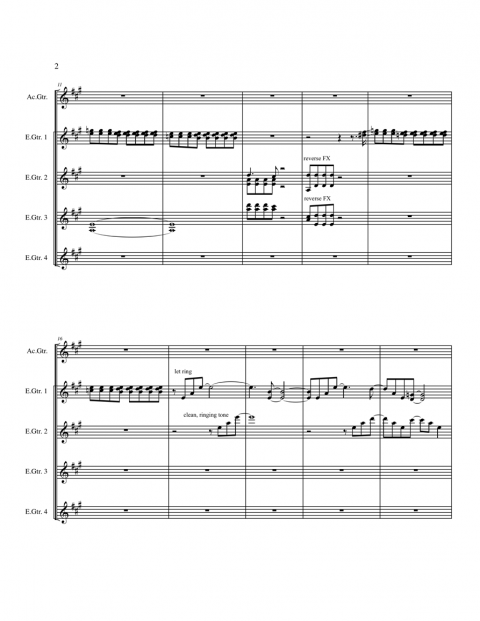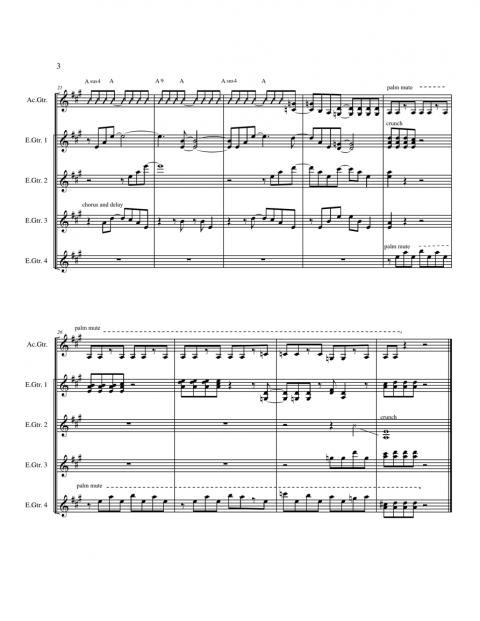Layering Guitar Parts

Mitch Coodley has composed music for TV, new, sports, and jingles, and was founder of Metro Music Productions, Inc. He is owner of Mitch Coodley Music and The Buzz Music Library.
My expertise is music that’s licensed for network and cable television shows. The current trend is to orchestrate music with guitar parts through a variety of textures, layering, patterns, frequency, and processing. Pattern-driven, layered textures can be heard in the music of mainstream bands such as U2 and Coldplay; in indie groups like Rogue Wave and Snow Patrol; and on shows like Lie to Me in Ryan Star’s “Brand New Day,” the show’s theme song. The approach is ubiquitous in production music and commercial spots.
The demo I’ve produced for this discussion shows several basic playing styles that can be layered or edited to create sections, backing parts, intros, fills, builds, and changing tapestries of sound. Instrumental guitar-driven music has to provide compelling movement, usually without a real melody. It should create shape, contrast, a full-frequency range, and movement or interest over time. For this demo, I played four electric parts and one acoustic part. Everything was recorded dry, direct into Logic Pro with Logic plug-ins for all but a few effects.
Audio: Layer of the Land



I played sampled, reversed, or truncated riffs in bars 13 and 25. Riffs never get old There’s an endless supply of riff-based guitar-driven music on TV shows, promos, and sports programming. I’ve generated a simple riff (electric guitars two and three), doubled, and split into panned guitars, high and low. Then I strip-silenced the parts and truncated the licks. In Logic Pro, “strip silence” is basically a digital gating function. It removes silence between attacks and creates separate bits of the remaining audio. This creates a purposely mechanical sound that gives you dead silence between the phrases, and again, more contrast. In bar 14, I sampled the lick and reversed it. That works as a phrase ending that leads into another bit of the processed eighth-note lick in electric guitar one. Here the drums drop out to provide further contrast and change.
In bars 17 through 24, with electric guitars one, two, and three, I played some high eighth-note patterns and put processing on them in bars 17 through 24. I’d go so far as to say, “He or she who controls patterns controls composition.” Patterns (repetitive ostinatos, semi-melodic figures, and everything in between) are very useful. Here I’ve worked with somewhat-melodic eighth-note parts that each breathe and leave space for one another. These are panned hard left and right, where the lower, crunchier part appears on the left and the higher, clean delay part appears on the right. To knit everything together, I added a third part that’s warmer. But when necessary, they remain transparent enough to handle other parts.
The low, crunch fifths like those played by electric guitar three starting in bar nine work anytime, anywhere, and under anything.
I played palm-muted parts (also called “blunting”) on the acoustic guitar and electric guitar four in bars 25 to 29. This approach works with constant eighths or repeating patterns. I doubled the acoustic part and panned the tracks to the left and right. Electric guitar four has a higher-pitched pattern that alternates between an A and an E. These muted parts alone are nice—light and airy—and would make a good intro or middle section, especially if chords were to change below them.
As for the arrangement, we have an introduction; a middle section, or verse possibilities; fills and dropouts, riffs, and an ending. To prove a point, at bar 33 I’ve put all the parts in at once. Normally I wouldn’t do this, but if you listen, you’ll hear that stacking all the parts together can be done tastefully. By simply playing a variety of parts in different registers with different frequencies and effects, you get a complete palette to work with. It’s easy to construct interesting arrangements with these elements.
I encourage you to experiment with guitar layering. Then mix and match, edit and mute, build and hold. In doing this, you can create a nearly orchestral sense with the song’s production. It’s also helpful when you need to create edited versions of your piece. I often have to make versions in 60-, 30-, 15-, and 10-second lengths. All these elements give me plenty to work with for creating a shape quickly or over time.
Let’s face it: A lot of “sessions” are done in your apartment sitting at your laptop. Whether you are the one playing the parts or not, as the producer you have most of the control. There should be a give-and-take between you and the guitarist as you create parts, apply effects, and develop ideas that work together. Start from a riff, a bass line, or a basic strum to set up your phrase. Then start layering. You’ll be amazed by how much music you can generate from four bars of material.
Video Tutorial




